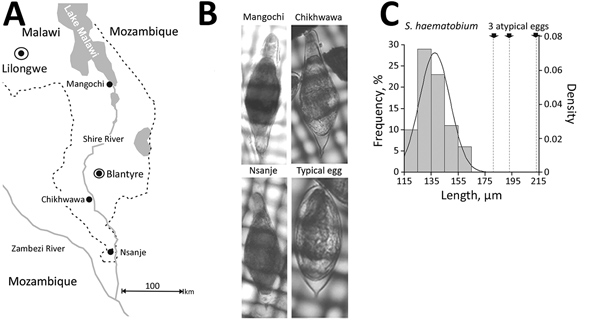Volume 25, Number 6—June 2019
Research Letter
Schistosome Interactions within the Schistosoma haematobium Group, Malawi
Figure

Figure. Investigation of atypical schistosome eggs retrieved from children in Malawi. A) Locations where urine samples containing Schistosoma haematobium eggs were collected from children in Mangochi (Samama village, 14°41′74.65′′S, 35°21′75.80′′E), Chikhwawa (Mpangani village, 16°03′62.99′′S, 34°84′10.63′′E), and Nsanje (Kastiano village, 16°90′63.98′′S, 35°26′65.78′′E) districts. Of the children sampled, ≈10% had atypical eggs in their urine, in an approximate atypical:typical ratio of 1:25. Note that the Shire River flows southward from Lake Malawi, linking the 3 sampled locations within the same drainage basin. B) Photomicrographs of a representative atypical egg from each location. Corresponding genotypes assigned for the mitochondrial cox1 and nuclear rITS loci: Mangochi, cox1 S. mattheei and rITS S. haematobium-mattheei; Chikhwawa, cox1 and rITS S. haematobium; Nsanje, cox1 S. bovis and rITS S. haematobium. A typical S. haematobium egg is shown for comparison. Sizes are not too scale. C) Histogram of length measurements for 83 typical S. haematobium eggs collected from Nsanje. Solid line indicates the associated density distribution. The mean length of this sample of typical eggs was 135 ± 28 µm (1 SD), with minimum 86 µm and maximum 180 µm. Arrows with dashed lines at right indicate the length of the 3 atypical eggs, which fall well outside the range of length variation of the 83 typical eggs as measured.